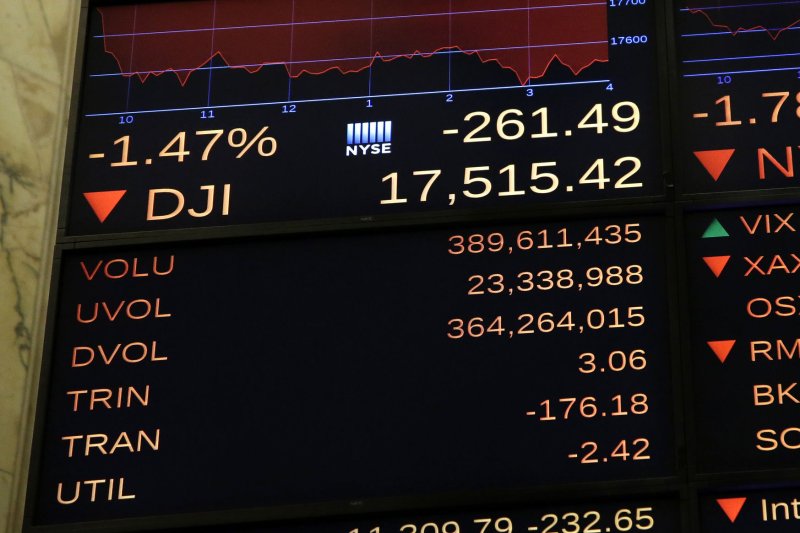A board at the NYSE shows Dow Jones Industrial Average down 261.49 points after the closing bell at the New York Stock Exchange on a day where trading was suspended for over 3 hours in the afternoon on Wall Street in New York City on July 8, 2015. Trading in all symbols was halted on the New York Stock Exchange floor Wednesday due to an apparent technical issue. The NYSE tweeted that it did not suspect a cyberattack. Photo by John Angelillo/UPI |
License Photo
During the Cold War, a thermonuclear conflict between East and West would have eviscerated much of society on both sides of the Atlantic. This delicate balance of terror was labeled Mutual Assured Destruction, commonly known as MAD. The acronym had obvious double meaning. Committing national suicide in a thermonuclear exchange was a clear-cut case of insanity on the part of Washington and Moscow. Unfortunately, the simplistic and negative use of the term MAD was misleading as the Cold War had far more complicated geostrategic and ideological sides to it.
Today, the term MAD can be reused and made more relevant to the current real and potential dangers to society at large. MAD now should be redefined properly to mean Mutual Assured Disruption as it applies to societies, individuals and standards of living. And this disruption can flow from acts of man and nature.
Disruption has always been present in the human condition. So what has intensified its power today? The answer rests in the combination of globalization and the diffusion of all forms of power, accelerated by the information and cyber revolutions encapsulated by the smartphone. These forces have now linked virtually all regions of the world in multi-dimensional forms of interconnectivity and interdependence. This interconnectivity and interdependence in a rapidly advancing technologically powered world are also creating, along with great opportunities, new fragilities and vulnerabilities. These fragilities and vulnerabilities are magnifying and distorting the effects of disruption.
As society embraces this interconnectivity, it also must accept the new costs imposed by heightened fragility and vulnerability. A few examples make this case. Last week in the U.S., the New York Stock Exchange went offline for several hours because of a computer "glitch." The United Airlines reservation system crashed shutting down all of its flights for much of a day. The impact was disruptive to clients, consumers and investors. Indeed, had these disruptions been traced to "hackers," imagine the response following the looting of some twenty million files of Americans from the Office of Personnel Management presumably to foreign hackers.
Meanwhile, the spread of the Islamic State beyond Syria and Iraq to Afghanistan reinforces the dangers of terror. Yet, for most people in the West and despite the horrors of September 11th in America and July 7th in London, the real impact of terror is disruption. A single transit through airport security shows how travel has been disrupted. And the tension between public safety and security and individual freedom is a further manifestation of these disruptive forces.
Acts of nature too are highly disruptive from freakish weather patterns in America with the West Coast in conditions of drought and much of the rest of the country literally awash in floods to the threat of pandemics such as Ebola. No doubt disruption could become destructive if cyber attacks wreaked huge physical damage by shutting down electrical power grids; terrorist-deployed weapons of mass destruction; and pandemics such as the Black Plague of the middle ages or the Spanish flu following World War I infected massive populations.
This shift from the nuclear driven MAD of the Cold War to today's new MAD by no means diminishes state against state conflict or war and violence in all forms. For example, the main numerical military advantage Russia holds over the West is short range or theater nuclear weapons that can be used to threaten or intimidate Europe. However, the increasing fragility and vulnerability of society because of dependence on new technologies and global interconnectivity must make minimizing disruption a new national security priority.
One can argue that there may be little new here. The collapse of the Chinese stock market last week parallels what happened in 1929, 1987 and 2008 here. And every great invention has certain downsides. The combustion engine led to greater pollution and dependence on oil as well as the side effect of many millions of deaths in traffic accidents. Penicillin has ultimately created drug resistant disease. Fortunately, progress has vastly outweighed the negative consequences.
What is needed is recognition and understanding of the power of disruption and the importance of setting in place policies and actions to minimize societal vulnerabilities and fragilities. A good start is modernizing our crumbling infrastructure. A second is taking on the cyber challenges with this appreciation of minimizing disruption. And a third is not transposing the likelihood of physical destruction across the entire spectrum of disruptions to every day life.
But whether politicians and the public will recognize this shift, from Cold War MAD to a globalized world's vulnerability and fragility posed by the new MAD of disruption, is perhaps one of the most under-publicized national security questions of our time.
_________________________________________________________________
Harlan Ullman is UPI's Arnaud de Borchgrave Distinguished Columnist as well as Chairman of the Killowen Group that advises leaders of government and business and Senior Advisor at both Washington D.C.'s Atlantic Council and Business Executives for National Security. His latest book is A Handful of Bullets: How the Murder of Archduke Franz Ferdinand Still Menaces the Peace.















